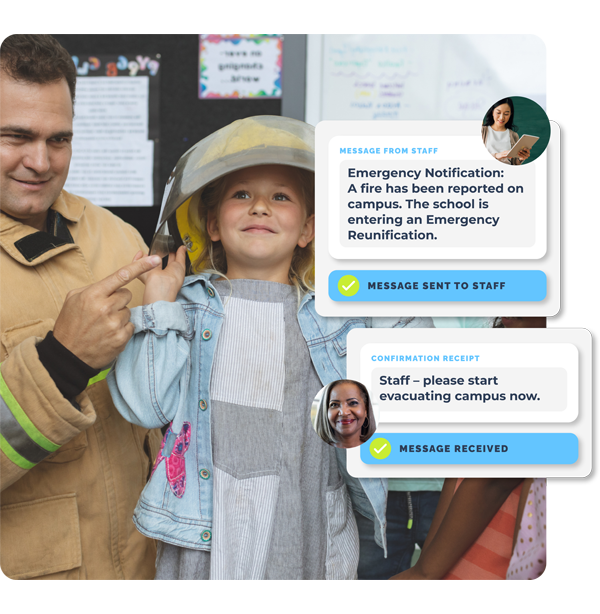The holiday season is an exciting time for schools, but it also comes with unique challenges. Increased student activities, special events, and a mix of staff and substitute teachers can create situations where emergencies may arise. When a crisis occurs, it’s vital to have a system in place to quickly deliver emergency instructions to all staff. Ensuring that teachers, administrators, and support staff know exactly what to do can make a big difference in the outcome of an emergency.
Why Emergency Instructions Matter in Schools
In a school setting, emergencies can take many forms, from medical incidents to fire alarms or natural disasters. The holidays can bring unexpected crowds, field trips, and after-school events, increasing the likelihood of situations that require immediate action. Emergency instructions help prevent confusion, keep everyone safe, and ensure that response times are quick.
Clear and accessible emergency instructions are crucial for maintaining order and minimizing panic during a crisis. Whether it’s a snowstorm, a lockdown situation, or a fire drill, your school must be prepared. Staff and students must understand their roles and responsibilities in any emergency scenario.
Methods to Quickly Deliver Emergency Instructions to School Staff
-
Use Digital Communication Tools
Digital tools can be a game-changer in delivering emergency instructions swiftly. School-wide messaging apps, email alerts, or internal communication platforms allow staff to receive notifications instantly. These tools can send real-time updates to staff on all campuses or departments, ensuring that everyone is informed simultaneously.
-
Implement Automated Alerts for Urgent Situations
Many schools use automated alert systems to send mass notifications in the event of an emergency. These systems can send alerts via text messages, phone calls, or emails. Using these tools ensures that important messages about evacuations or safety measures reach staff quickly and reliably.
-
Leverage the PA System for Immediate Broadcasts
A public address (PA) system is an essential tool in any school’s emergency plan. In a crisis, a well-trained staff member can use the PA to broadcast clear, concise instructions to all staff and students. Regular practice with the PA system ensures that it can be used effectively when every second counts.
-
Display Emergency Procedures in Visible Locations
Post emergency procedures in key areas where staff regularly gather, like teachers’ lounges, break rooms, and staff meeting areas. Ensure that emergency plans are easily accessible and prominently displayed. These posters should include basic instructions for various emergencies, such as evacuations, medical emergencies, and lockdown procedures.
-
Conduct Regular Staff Training Sessions
Consistent training is vital for ensuring that everyone in the school understands their role in an emergency. Whether you have full-time teachers or substitute staff, every employee should be familiar with the emergency protocols. Simulate emergency scenarios during staff meetings or professional development days to test response times and coordination.
-
Provide Emergency Response Kits for Every Classroom
Equip each classroom with an emergency response kit. Include first-aid supplies, flashlights, walkie-talkies, and a list of important contacts. This allows teachers to respond to minor medical emergencies immediately and ensures that communication remains open during a larger crisis.
-
Define Roles and Responsibilities Clearly
In an emergency, everyone should know exactly what to do. Establish a clear chain of command so staff members know who to follow for instructions. For instance, the principal might be in charge of contacting authorities, while the school nurse handles medical emergencies. Communicate this information regularly to prevent confusion.
Developing Effective Emergency Instructions for Schools
When creating emergency instructions, clarity is essential. Instructions should be simple, direct, and easy to follow, especially in high-stress situations. Keep emergency protocols short, clear, and specific so that staff can act without hesitation.
Here’s how to develop emergency instructions that everyone can understand:
- Identify Common School Emergencies: Consider the most common emergencies that could occur in your school, such as fire drills, medical emergencies, lockdowns, or natural disasters. Tailor your instructions to address these scenarios.
- Include Step-by-Step Instructions: For each type of emergency, provide detailed steps. For example, during a fire drill, specify which exits to use, where to assemble, and the procedure for accounting for all students.
- Designate Specific Staff Roles: Assign specific duties to staff members. For instance, some staff may be responsible for guiding students to safety, while others check the building to ensure all areas are clear.
- Share Contact Information: Include emergency contact numbers for local authorities, medical facilities, and key school administrators. Keep this information handy for quick access in an emergency.
- Use Visual Aids: Include floor plans or evacuation maps, and consider color-coding instructions for different types of emergencies. Visuals can help staff quickly understand where to go and what actions to take.
Testing and Refining Your Emergency Plan
Once your emergency instructions are in place, it’s essential to test them. Regularly conduct drills that simulate different types of emergencies, including fires, lockdowns, and medical incidents. These drills will help staff practice the necessary steps, as well as identify any gaps in the emergency plan.
After each drill, debrief with staff to gather feedback. Ask teachers and support staff what worked well and what could be improved. Use their input to refine your instructions and update your emergency protocols as needed.
Ensuring Instructions Reach All Staff, Including Substitutes
During the holiday season, your school might have a mix of regular staff and substitutes. Ensuring that every employee receives emergency instructions is critical. Here are some tips for making sure all staff, including substitutes, are prepared:
- Include Emergency Procedures in Sub Plans: Make sure that emergency instructions are included in substitute teacher plans. Each substitute should be aware of the school’s emergency procedures before they step into a classroom.
- Communicate Through Multiple Channels: Use a mix of communication methods, such as digital alerts, printed handouts, and in-person briefings. Ensure that substitutes and new staff have access to all relevant emergency information.
- Prepare for Varying Shift Schedules: Ensure that staff working in non-traditional shifts or after-school programs receive emergency instructions as well. A reliable communication system will ensure they are informed, even if they work irregular hours.
- Offer Multilingual Emergency Instructions: If your staff or student body speaks multiple languages, make sure that emergency instructions are available in those languages. Clear communication is essential for everyone’s safety.
Being Ready for the Unexpected
Emergencies are unpredictable, but with proper preparation, your school can respond effectively. Whether it’s a small incident or a larger crisis, the key to handling emergencies well is having a clear, tested plan in place. By making sure all staff have access to emergency instructions and are trained to follow them, you ensure a safer environment for everyone—students and staff alike.
Conclusion
The holiday season may bring extra activities and excitement to your school, but it also increases the chances of an emergency. Ensuring that your school staff can quickly access emergency instructions will help keep everyone safe and calm. Use digital tools, regular training, visible instructions, and well-planned procedures to ensure your team is prepared. By staying organized and proactive, your school can navigate any emergency that arises with confidence and clarity.



